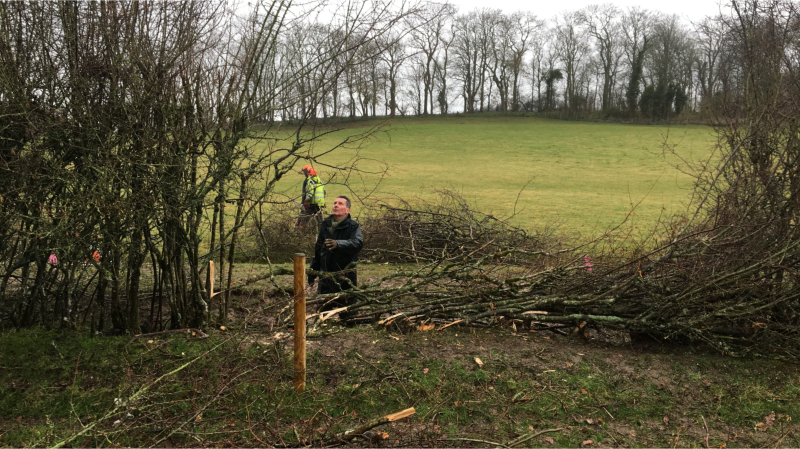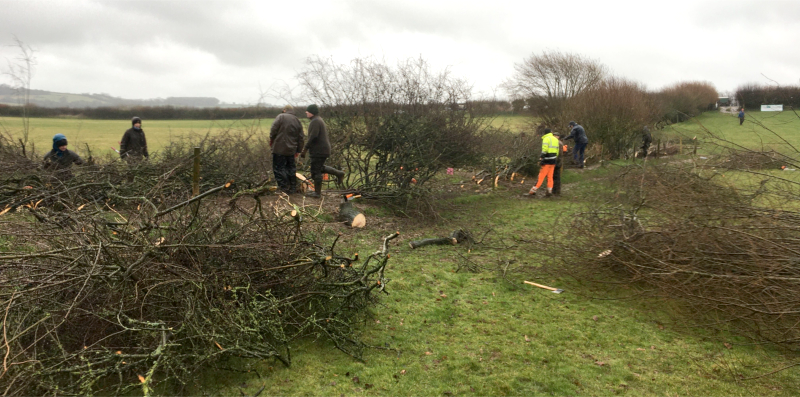Here at Ashridge the ‘dormant season’ is anything but – in fact it’s our busiest time of the year.
But we’re not the only ones kept busy in winter. While we’re despatching bareroot trees and hedging plants from the nursery, out in the fields hedge layers are hard at work.
Hedge laying has been practised for hundreds of years, but it’s a skill that nearly died out in the last century when hedgerows were grubbed up as agriculture became more mechanised. Luckily hedge laying has experienced a revival with many (King Charles among them) championing the environmental value of properly maintained hedges.

Hedge laying competition in Somerset
Simply put, hedge laying involves clearing an overgrown hedge of brambles and excess growth and cutting the remaining upright stems (‘pleachers’) nearly through and laying them (in the Dorset/Devon style at least) as horizontally as possible on the ground or bank. This encourages upright new growth and creates a stock proof barrier with a thick base. Hedge laying is only carried out in the dormant season (and before the nesting season); typically, hedges need to be laid about every 15 years.

Hedge laying in action at the Blackmore and Sparkford Vale competition
See Hedge Laying in Action
As suppliers of bareroot hedging, Ashridge is proud to sponsor the B&SV Annual Hedge Laying Competition. This year’s competition takes place on Sunday 26th February at Babcary, Somerset and is the 26th in its history. Around fifty entrants are expected and will work in the North Dorset/South Somerset style, using pegs and not stakes.
The hedge that’s being tackled is believed to be an old ‘Enclosure hedge’ – a hedge that owes its existence to the enclosure acts of the late 18th-century. Such hedges often consist of hawthorn and blackthorn.
The competition is a great place to learn about hedge laying by watching professionals at work and even have a go yourself. Novice hedge cutters are welcome, and no previous experience is needed as two professionals will train Novice Class entrants. Chain-saws are permitted, as well as traditional hand tools.
Entry is free and organisers provide a snack lunch and each competitor takes home a case of beer. Sounds like a good deal to us! You can enter up to two days before the competition – contact Peter FitzGerald [email protected] for more details.
In Praise of Hedges
Good fences make good neighbours, as the old saying goes. But what makes a good fence? It all depends on what you want to enclose of course, but we believe a hedge is hard to beat.

Juvenile Robin enjoying a hawthorn hedge in summer
Hedges tick so many boxes: as well as being attractive they provide corridors and habitat for wildlife and capture carbon. They are natural windbreaks and help to mitigate soil erosion and flooding. The good news doesn’t stop there – bareroot hedging plants are economical to buy and establish quickly, meaning you (and your neighbours) won’t have long to wait before you can enjoy their benefits. And when it comes to maintaining mature hedges, laying is not the only way of keeping them in good shape. Trimming with shears or electric trimmers is the go-to for most people, as Garden Ninja Lee Burkhill explains in his ultimate beginner’s guide to hedge cutting, pruning and trimming.
Choosing and Planting a Hedge
When it comes to planning a new hedge, there’s no such thing as one size fits all. A formal, evergreen yew or privet hedge might be just the ticket for a tennis court or swimming pool (where their dense foliage will provide shelter and privacy without any pesky autumn leaves to collect) but both are toxic to livestock and therefore unsuitable for enclosing a paddock.
If you are planting a hedge to enclose livestock such as cattle and horses, you’ll also want to avoid blackthorn (whose long thorns can scratch an animal’s eye), and, similarly, a child friendly hedge should also be thornfree.

Beautiful black angus cow next to stock friendly hedge
A new hedge is worth some pre-planning – after all you are planting a feature that should last generations. Our hedge mixes make that choice easier, and cover every eventuality, whether you want an all-season ornamental garden hedge or a berry-rich bird friendly hedge tailored to cater for avian wildlife. We also stock essential accessories like mulch mats and pegs and spirals.
For human foodies, we have an Edible Hedge mix containing five species of fruit and nut trees to complement any kitchen garden, and Elspeth’s Edibles mix featuring eight edible species that are ideal for hedgerow jam devotees.
Our Native Conservation Hedging and Livestock Friendly Hedging mixes offer terrific value for landscape and agricultural settings and will grow in almost any site. If you live near the sea your hedge will probably need to be able to cope with an exposed site, salty winds and free-draining soil. Our Coastal Hedging Mix contains seven species chosen to do just that, including the iconic seaside plant tamarisk.
Whether you’re using a ready-made mix, or freestyling with your own blend of plants, once you’ve planted a hedge you will experience a unique sense of satisfaction, one that will only grow as your hedge establishes. Hedges have a positive impact on the environment but their effect on human health cannot be underestimated either. The icing on the cake is that bareroot hedging plants are super easy to plant – just check our Bareroot Native Country Hedge planting video for guidance and get your hedgerow journey underway.
